Day Trip to Segovia: 1-Day Itinerary


Perfect for a 1-day trip from Madrid, Segovia is the kind of place where you can stroll through centuries of history and finish your day with a feast that will leave you in a food coma. Segovia offers everything from an iconic ancient Roman aqueduct to a massive cathedral, but best of all, it’s the views of the castle on the limestone ridge that’ll get you the most excited.
I explored Segovia as part of a road trip around Castile and La Mancha. However, I quickly realized that parking in Segovia is about as easy as finding a unicorn in a haystack. If you’re just planning a day trip, ditch the car and take the train—it’s faster, easier, and saves you the headache of parking.
In this article, I’ll tell you what to do in Segovia for one day, all bundled up into a detailed itinerary complete with prices, logistics, and my tips for each spot. You’ll find FAQs at the end of the article.
>>Read more: The best day trips from Madrid<<
What to do in Segovia Spain for a day?
Here’s what you’ll see on your 1-day Segovia itinerary, in the order you’ll visit them in:
- All the viewpoints (miradores): When the best thing to see is a place to see things.
- Sanctuary of Our Lady of Fuencisla (Santuario de Nuestra Senora de la Fuencisla): Perfect for a peaceful visit and stunning views of the city.
- Royal mint (Real Casa de Moneda de Segovia): Where Spain's coins got their bling with water-powered machinery.
- Royal Mile (Calle Real): The main drag of Segovia, lined with historical buildings and shops.
- San Martin Church (Iglesia de San Martin): A charming Romanesque church with a striking golden altar.
- Casa de los Picos: Known for its unique façade covered in granite points.
- Roman aqueduct: An engineering marvel still standing after nearly 2000 years.
- Jewish Quarter: Narrow, atmospheric medieval streets.
- Segovia Cathedral: The last Gothic cathedral built in Europe.
- Segovia Castle (Alcazar de Segovia): The reason Segovia is so picturesque.
- Cochinillo @ José María Restaurant: Roast suckling pig is Segovia’s star dish and local delicacy, and José María Restaurant is the go-to spot to try it out.

Are you ready for a full day of beautiful viewpoints, temples and squares of Segovia?
Getting to Segovia
- Driving: If you must drive, prepare for limited and expensive parking. Segovia is compact, so once you’re parked, everything is in walking distance. From Madrid to Segovia, the drive takes a little over an hour.
- Train: The high-speed train from Madrid to Segovia takes less than 30 minutes and leaves very frequently. It's the best option to avoid the hassle of parking. Just check prices, they seem to vary wildly.
- Train station in Segovia: The Segovia train station (Guiomar Station) is located about 20 minutes on foot from the city center on the south side. For this itinerary, it makes sense to take a taxi to the starting point in the north of town.
Orientation and map
Segovia is a compact and easily walkable city—but you’ll still get have at least 8 km (5 mi) under your belt by the time you’ve seen all the top spots! The main tourist sights are conveniently clustered together, with the train station a little to the south:
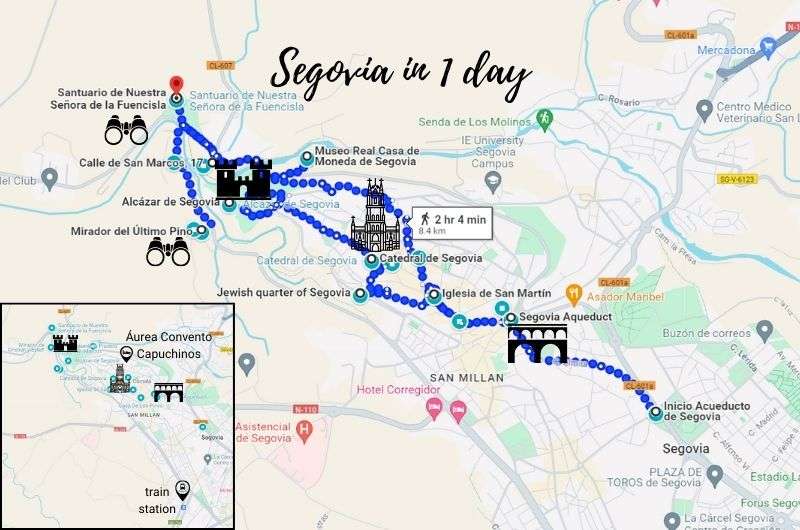
Segovia is compact, but it’s a full day and a lot of walking. If you’d prefer a more relaxing pace, indulge at the 5-star Áurea Convento Capuchinos Hotel—it’s a former monastery right in the historic city center!
Located at the entrance of the historic center in the south is the Roman Aqueduct. The main artery of the city is the Royal Mile (Calle Real), connecting the aqueduct to Plaza Mayor, which is where you’ll find Segovia’s Cathedral. Situated on a cliff at the far end of the city in the north is Alcázar of Segovia. The best city viewpoints are in this area as well.
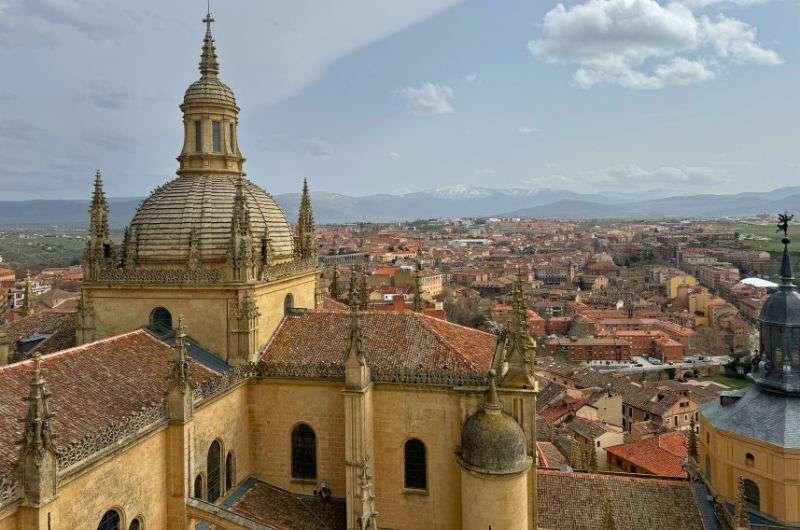
Cathedral of Segovia
Five-star hotels in Segovia—there’s just one
If you prefer to take your time and aren’t on a mad dash back to Madrid, there are some stellar hotels in Segovia. Not many, but they do exist.
There’s a single 5-star hotel in Segovia called Áurea Convento Capuchinos (by Eurostars Hotel Company). It used to a monastery, so you get all the things—stone walls, vaulted ceilings, and now, a level of luxury that monks can only dream of. Picture waking up in a room where nuns once meditated or having gourmet meals in a former chapel… and there are views!
If you can deal with one less star, check out the similarly charming but a little less luxurious (and cheaper) 4 Hotel Cetina Palacio Ayala Berganza. This one is light, bright, and I’m pretty sure they sourced some of their chairs from the same place Áurea Convento Capuchinos did.
My top tips for one day in Segovia
- Don’t combine Ávila on a day trip with Segovia. Both towns deserve a full day and there’s plenty you’d miss if you tried to fit in both at once.
- To get a good photo of Segovia Cathedral within the city, go to the rear courtyard, accessible only from inside the cathedral.
- For a shot of the whole cathedral (it’s big, so it’s hard to take a photo of up close!), your best bet are the miradores (viewpoints) at the beginning of this itinerary.
- Treat the Jewish Quarter as an optional stop. If you’re running out of time, skip it—it's not that special.
- Take the time to walk along the aqueduct to find the beginning of it to get a feeling for how it used to work. It’s like looking for a pot of gold at the end of a rainbow!
And now, a detailed breakdown of each stop on your Segovia day trip:
Stop 1: All the viewpoints | Free, always open
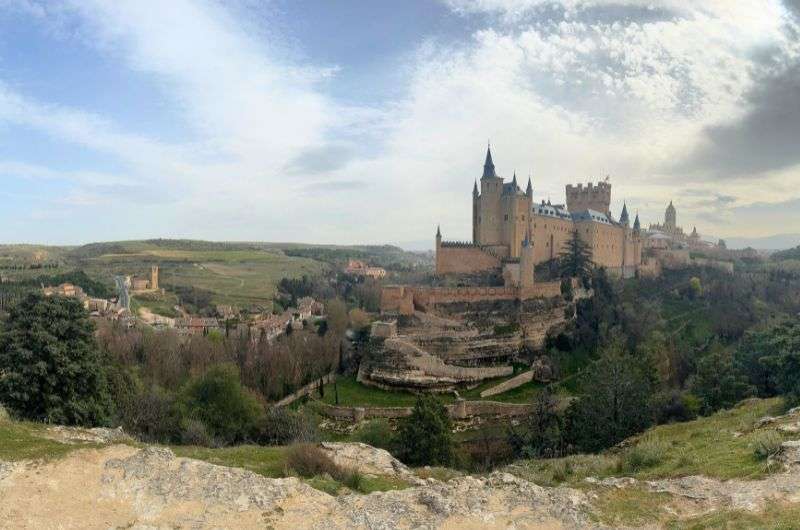
There are many great viewpoints in Segovia!
Time spent here: 60 minutes
Price: Free
Tip: All the viewpoints are close to each other and quick to walk between, and yes, you need to see all of them. You’ll be able to appreciate the castle and cathedral from different angles at each one.
Start your day in Segovia with all the miradores (viewpoints)—it’s the best way to comprehend the grand scale of Segovia and get a proper appreciation of the place. It’s gorgeous, it’s free, and it’s so good I’ll be sending you back here at the end of this itinerary, because sunset takes it to another level.
Unless this is the first article you’re reading about Segovia, you’ll know that Segovia’s Alcazar (castle) is absolutely spectacular and ginormous and basically makes Segovia what it is. It sits up on a limestone cliff, and you going to the viewpoints gets you front row seats to the show that is Segovia.
All of the viewpoints are located on the northwestern side of the city, so if you’re arriving by train, you’ll want to hop in a taxi to cover the 3.5 m (2 mi). If you’re driving, there’s free parking near the first viewpoint. Hopefully there will be spots available there, otherwise you’ll need to search for another place to leave your vehicle.
Mirador de La Pradera de San Marcos

This view has a fairytale vibe!
First up is Mirador de La Pradera de San Marcos and it’s a goodie! I half expected a dragon to fly out when I saw this view.
Mirador de Cristian y Estefi
A stone’s throw away (if you throw uphill) from the first viewpoint is Mirador de Cristian y Estefi. You’ll be rewarded with breathtaking views that make you want to snap a million photos before moving on to the next one.
Mirador de los Dos Valles
Then, continue up to Mirador de los Dos Valles. It’s a five-minute walk from the last viewpoint. The castle looks completely different from this angle—almost like a tower. Note the viewpoint is above the road on a cliff, not right on the road (some people seemed to stop prematurely).
Mirador del Último Pino
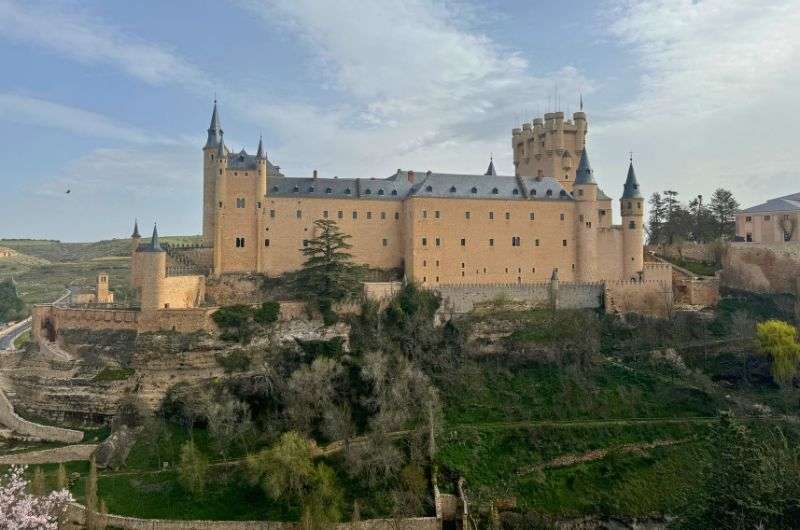
The Alcázar from another angle at another viewpoint
The last one is the biggest challenge to get to, but nothing super tough if you aren’t a total couch potato. Mirador del Último Pino is a five-minute stair climb. If you make it up there, expect to be on the same level as the castle where you’ll have earned epic views from yet another angle.
Then, head back down and over to your next stop.
Stop 2: Sanctuary of Our Lady of Fuencisla | Free, open daily 8 am–8 pm
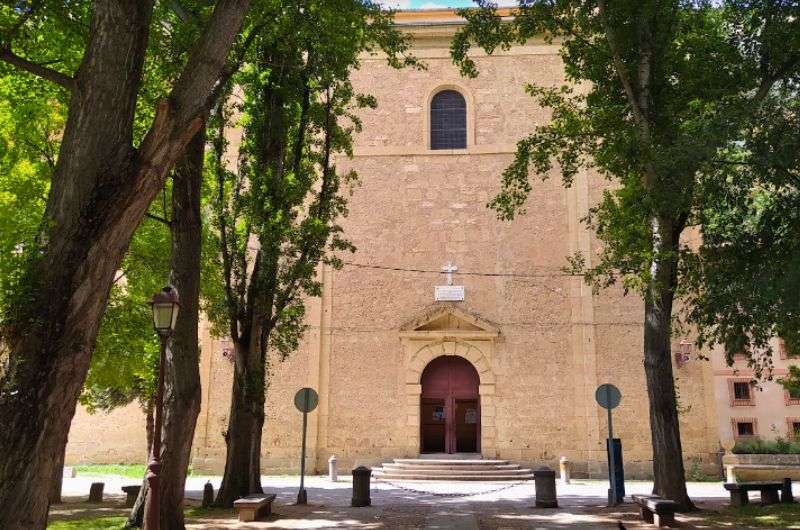
Sanctuary of Our Lady of Fuencisla
Distance from last stop: 1.2 km (0.8 mi), a 20-minute walk
Time spent here: 30 minutes
Opening hours: Daily 8 am–8 pm (for the sanctuary)
Price: Free
Next, climb back down from the viewpoints and make a stop at the Sanctuary of Our Lady of Fuencisla (Santuario de Nuestra Señora de la Fuencisla). It’s a quiet, serene spot with a very golden alter where it seemed very appropriate to keep silencio as there were people deep in thought hanging out with God and whatnot.
What’s really cool is that they actually encourage you to take photos and share them on social media. It's not every day you find a historic church that's all about those Instagram likes!
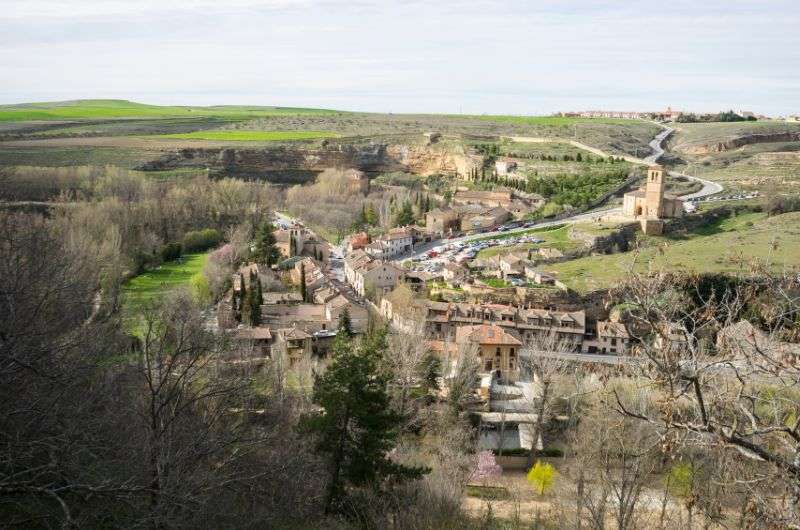
More views...
You only need a couple of minutes inside, but also take some time to get excited about finally going to explore inside the city walls by checking out the park out front. There are more views of the Alcazar and Cathedral out there, as well as plenty of benches.
And then you’re almost ready to go iside the city. ALMOST.
Stop 3: The Royal Mint | Entry fee EUR 6, open daily 10 am–2 pm and 4 pm–6 pm, Sundays 10 am–2 pm
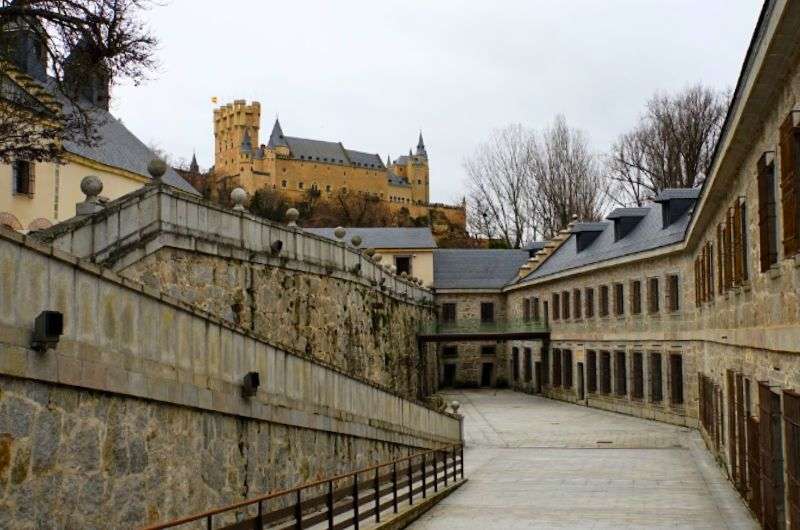
Real Casa de Moneda de Segovia
Distance from last stop: 1.2 km (0.7 mi), a 17-minute walk
Time spent here: 1 hour
Opening hours: Daily 10 am–2 pm and 4 pm–6 pm, Sundays just 10 am–2 pm
Price: EUR 6
Tip: Get the audioguide, because English signage is non-existant. Make time to stroll the garden and the Interpretation Center of the Aqueduct, too.
Next walk to the birthplace of Spanish money—the Royal Mint. This museum is tucked away outside the fortified city walls, in the pretty Eresma Valley, so hopefully you’re still open to more views, because you’ll be getting some!
King Philip II chose the location of the mint in 1583, and he did a brilliant job! By 1588, the building was up and running, making it the first mechanized currency minting factory in Spain.
Walking into the Casa de Moneda, you immediately see that the building is fantastically renovated and has been turned into a great museum with all kinds of interesting exhibits. The museum is modern, with a cool collection and machine recreations that show the entire process from the arrival of the metal to the final coin.
Many exhibits lack information in English, so grab the audio guide to fill in the gaps, because it makes no sense walking through without knowing how these things actually worked. The history of money and this mint is presented very well in the audio guide, and it’s pretty entertaining, too.
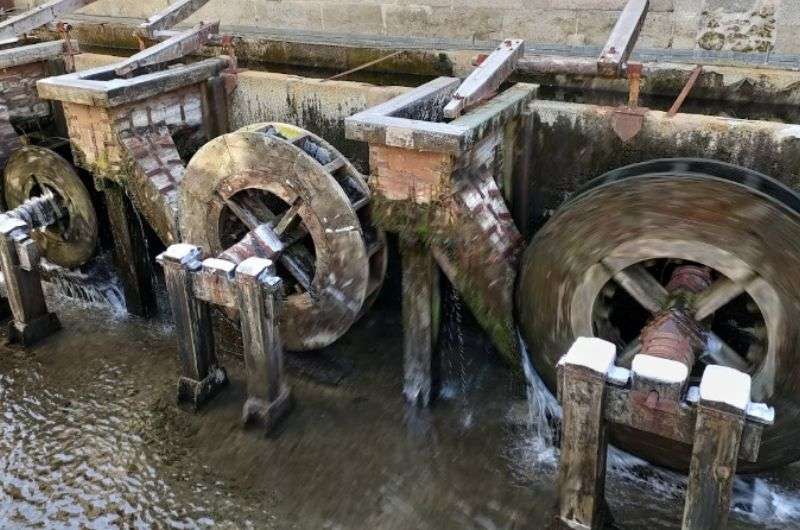
The waterwheels
The location due to the availability of water from the Eresma River, which powered the hydraulic machinery. This use of water power was pretty revolutionary. You can still see the waterwheels (recreated, not original) and channels that powered the minting machines.
Your ticket also includes the Interpretation Center of the Aqueduct and the King's Garden, so if you get here mid-morning at the latest, you’ll have time to look at those, too.
Stop 4: Plaza Mayor and the Royal Mile | Free, always open

Plaza Mayor de Segovia
Distance from last stop: 1.1 km (0.7 mi), a 20-minute walk
Time spent here: 10 minutes unless you stop for coffee
Price: Free
Tip: You’ll get your first up-close look at the cathedral, but don’t go in just yet!
Now it’s time to finally enter the city walls. Don’t be put off by more walking, it’s a very pretty walk that gives meaning to the saying “the journey is the destination”. Also, make sure to enjoy the walk, because the main square, Plaza Mayor, isn’t anything that special. It’s a square that happens to be where Segovia’s Cathedral lives, so you’ll finally get an up-close look at it. But don’t go in just yet! We’re building up to it, ok?
For now, just take a wander around the square and keep going to your next stop—the aqueduct. Plaza Mayor is where the “Royal Mile” starts—it’s the main artery of the city’s historic center. It’ll take you all the way to the aqueduct, just follow the crowds. As you walk along the Royal Mile, you'll pass by a slew of significant landmarks, a few of which are worth stopping at…
Stop 5: San Martin Church (Iglesia de San Martin) | Entry fee EUR 4
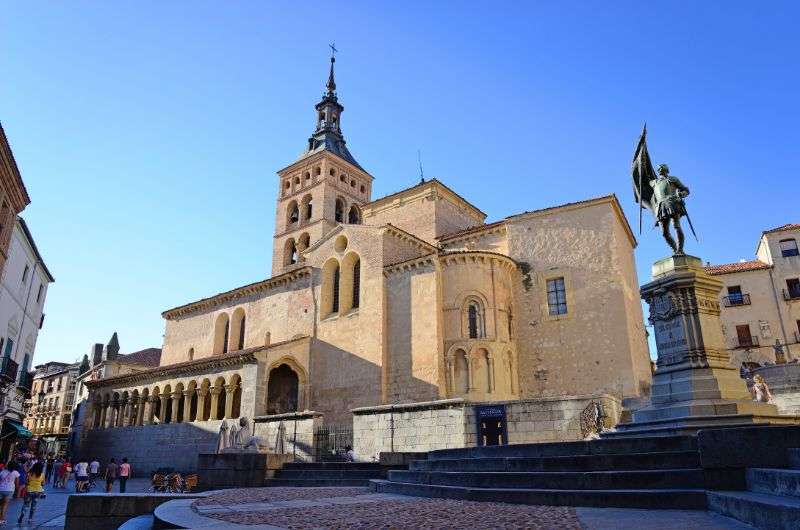
San Martin Church
Distance from last stop: 300 m (0.2 mi), a 4-minute walk
Time spent here: 10 minutes
Price: EUR 4 with audioguide
Tip: It’s a short and sweet visit on the Royal Mile on the way to the aqueduct.
… like San Martin Church (Iglesia de San Martin). It’s a charming church with a gold altar that’ll make your jaw drop. Built in typical Gothic style, of course. Its exterior is striking, with Romanesque stones and an impressive façade. The tower adds a nice touch.
Your visit will be over in 5-10 minutes, but don’t miss the hilariously short audio guide that comes with the EUR 4 entrance fee.
Stop 6: Casa de los Picos | Free, always “open”
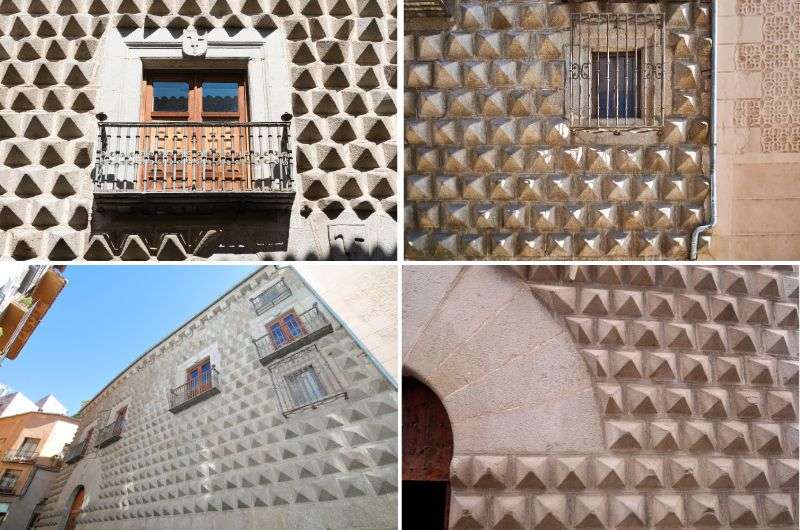
Casa de los Picos
Distance from last stop: 250 km (0.1 mi), a 3-minute walk
Time spent here: 30 seconds
Price: Free
Tip: It’s on the main drag, so you aren’t going out of your way to see it.
Then, continue walking until you reach Casa de los Picos, which translates to “House of the Pointy Things.” Or something like that. It’s famous for its unique façade, covered in granite points that look like they come from a medieval torture device. And that’s all it is.
It’s a quick 30-second stop for a photo, but not a major attraction, I thought it was just ok. There’s an art school inside, so you really are here to just look at the pointy things.
Stop 7: Roman Aqueduct | Free, always open
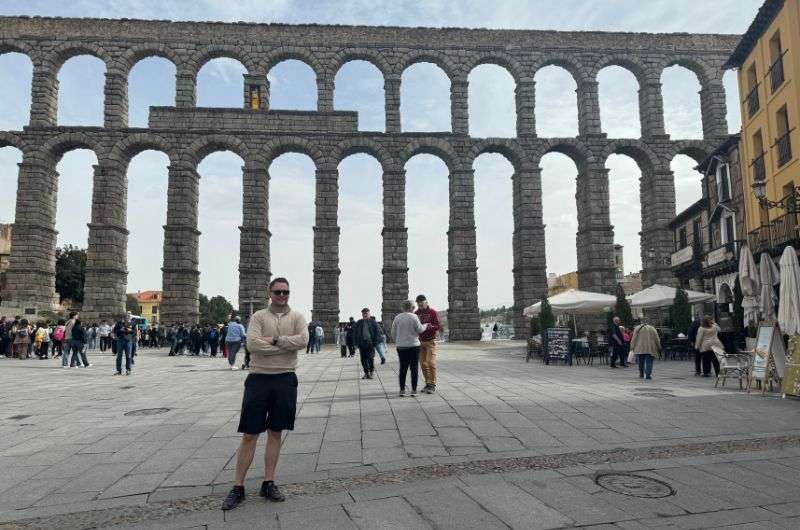
Mind-blowing Roman Aqueduct
Distance from last stop: 250 km (0.1 mi), a 3-minute walk
Time spent here: 1 hour
Opening hours: It’s right there out in the open, so it’s always visible
Price: Free
Tip: Take time to find the beginning of the aqueduct, it’s super interesting and rounds off the experience much better than just taking a photo in front of it and leaving.
Finally, no day trip to Segovia could be complete without visiting the Roman Aqueduct. It will blow your mind.
The Segovia aqueduct was used to transport water from the Frío River, about 17 km (10.5 mi) away, to the city. It’s composed of roughly 24,000 granite blocks and stands at about 28.5 m (93.5 ft) at its highest point. And it’s huge.
Back in the day, the water brought in by the aqueduct served purposes like supplying the public baths, fountains, and private households. Amazingly, the aqueduct continued to be used for water transportation until the 20th century, serving modern homes and businesses. It was still being used to transport water up until the 20th century (the 70s). Is that ultra cool or what?
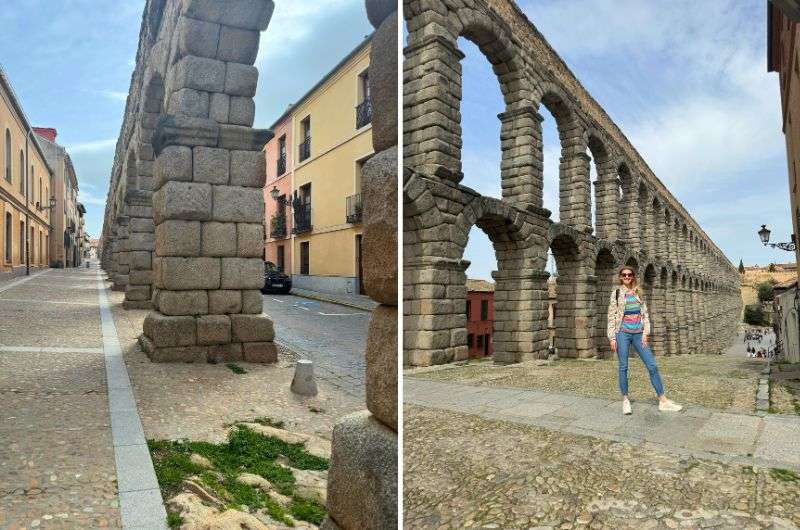
When you consider that this thing has been standing here for thousands of years almost unchanged, it's unbelievable
Wait until you realize that this thing has been standing here for almost 2,000 years without a single dab of mortar! The stones are perfectly cut to fit together, relying solely on gravity and brilliant engineering. It’s mind-boggling when you consider all the history it’s survived—no invaders, natural disasters, or misguided renovators have managed to knock it down.
The main spot to see the aqueduct from is the square right under it—Plaza del Azoguejo, and then the viewpoint that you get to by walking up the stairs at one end of the plaza.
But I wasn’t happy with just that and decided to walk alongside the aqueduct, searching for the beginning—highly recommended! It felt like I was looking for the beginning of a rainbow, minus the pot of gold. Be ready to walk for quite a bit—20 minutes at a steady pace along the water channel takes you to Inicio de Aqueducto (start of the aqueduct on Google Maps). There you’ll find a small structure marking the beginning. Pretty cool!
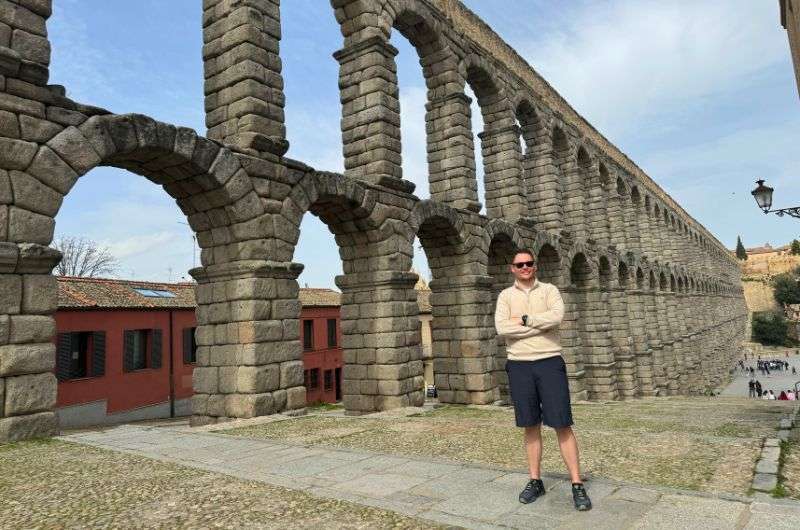
I recommend a walk along the aqueduct; you’ll get a much better understanding of how it worked
Stop 8 (optional): Jewish Quarter | Free, always open
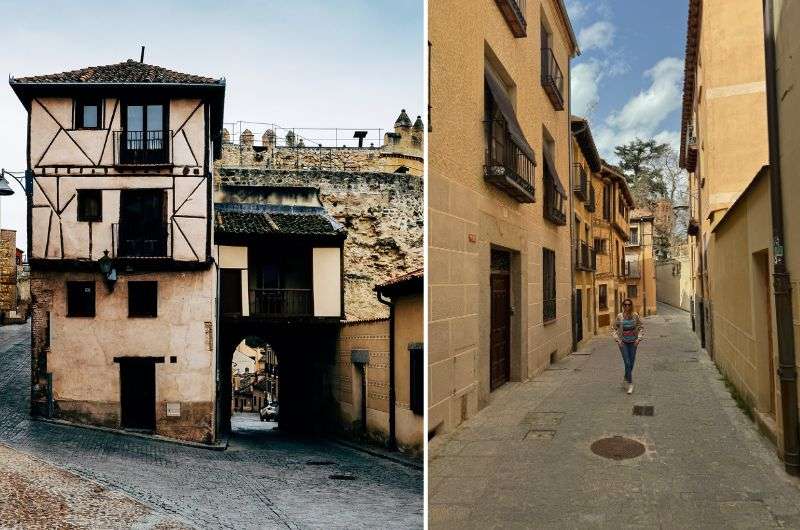
Take a walk through the streets of Segovia’s Jewish Quarter
Distance from last stop: 700 m (0.4 mi), a 12-minute walk
Time spent here: 10 minutes without any stops, more if visiting cemetery and museum
Price: Free
Tip: If you’re running out of time during your Segovia day trip, you may need to skip the Jewish Quarter.
La Judería is where Jews lived until they were expelled during the Reconquista. You can also visit the cemetery and a small museum.
I’ve put this stop as optional only because you only have one day in Segovia and you may be running out of time. Remember, you haven’t seen the top things in the city yet—the cathedral and the castle, so keep aside plenty of time for those.
Then again, the Jewish quarter is just a few intertwined narrow streets, so you can easily just walk through without delaying your itinerary too much. It’s not that much of a detour when walking to your next stop, the cathedral.
Stop 9: Segovia Cathedral | Entry fee EUR 4 + EUR 7 for tower, open Monday to Saturday 9 am–9:30 pm, Sundays 12:30 pm–9:30 pm
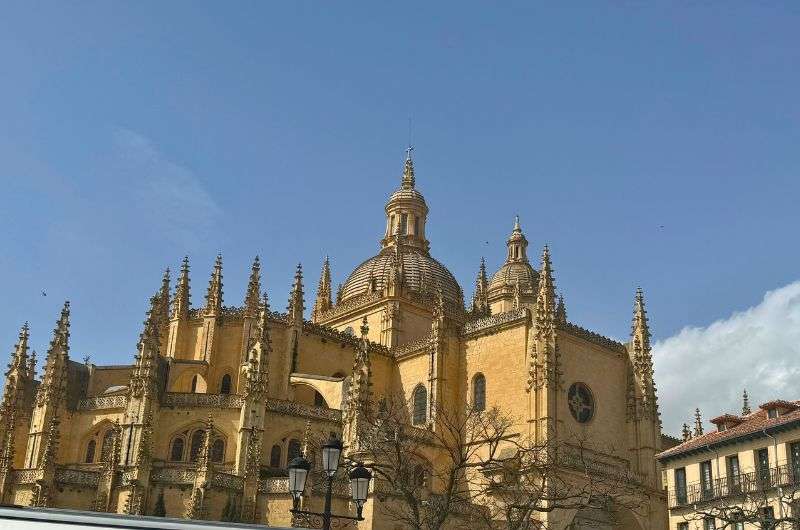
Segovia Cathedral aka Cathedral of Our Lady of the Assumption and of Saint Fructus
Distance from last stop: 400 m (0.3 mi), a 5-minute walk
Time spent here: 1 hour
Opening hours: Monday to Saturday 9 am–9:30 pm, Sundays 12:30 pm–9:30 pm, tower tours go several times a day between 10:30 am and 7:30 pm
Price: EUR 4 + EUR 7 for the tower
Tip: You can book your visit online to skip the sometimes long lines at the ticket desks. Yes, plural—there’s a separate one for the tower (and it has limited capacity per day).
If you were impressed by the aqueduct, just wait until you step foot inside Segovia’s Cathedral; full name: Cathedral of Our Lady of the Assumption and of Saint Fructus. So let’s just stick to calling it “the cathedral”. This place is massive, but next to the monumental Alcázar, it actually looks small. I had to chuckle when I noticed this. In reality, the cathedral spans an impressive 14,025 square meters (151,000 square feet)—so not tiny at all!
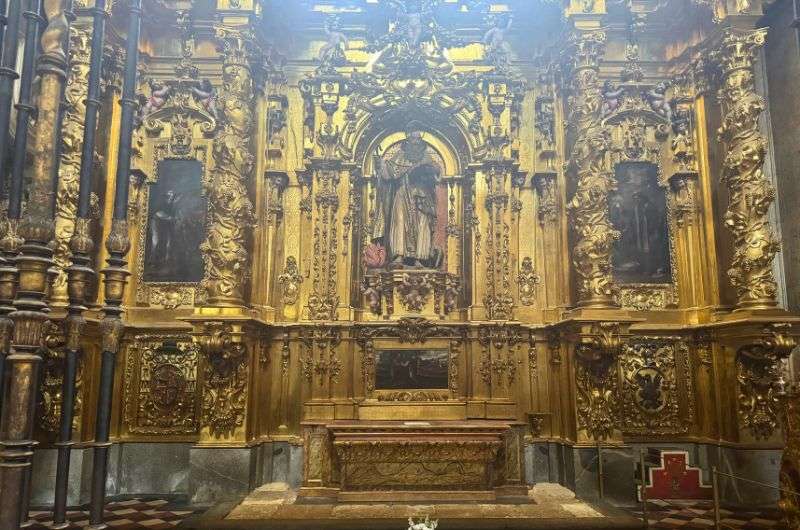
Gilded altar of Segovia Cathedral
You pay EUR 4 for general admission and an extra EUR 7 if you want to include the tower as well. You can buy tickets online in advance, which is a good idea if you want to beat the lines and guarantee you get into the tower—they limit the number of people that can go in each day. You have to go up with a guide at certain times, so it makes sense to get your time slot prior so you can plan the rest of your day accordingly (especially in busy periods or during holidays). If you get there without a ticket, you could end up waiting weirdly long for your assigned tower time.
Inside the cathedral, expect Gothic everything: high vaulted ceilings, stained glass windows, and about a million sacristies (okay, maybe not literally, but it felt like it), art, and life-size statues. The Spaniards sure know how to make everything gleam with gold. It also houses the remains of 256 people. To me it all looked relatively new (I mean, not the dead people), and that’s because King Charles I had it rebuilt further from the castle after the previous one was destroyed in a siege of the castle.
On the other hand, there are no meaningful descriptions inside the cathedral, which is a bit of a letdown compared to the cathedral in Avila. It makes sense to get the audio guide if you aren’t on a guided tour and don’t want to be just cluelessly walking around without any context.
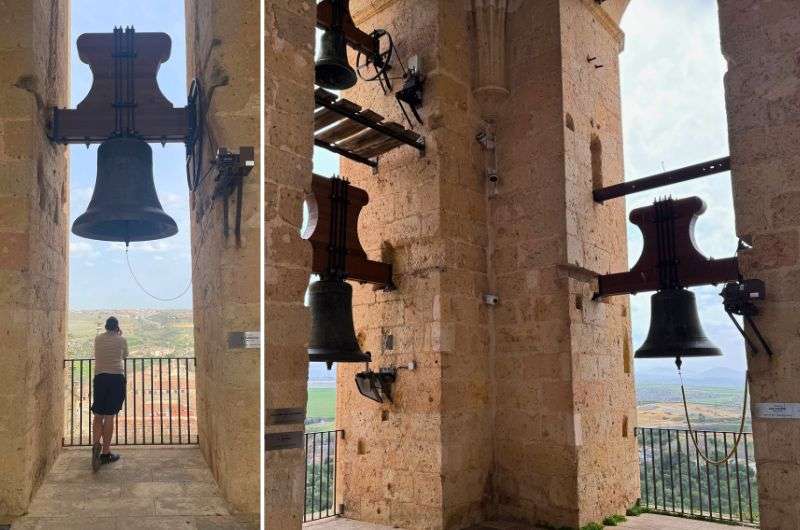
Here I am enjoying the beautiful views and listening to the audio guide on the bell tower of Segovia Cathedral
The best spot for a photo of the cathedral within the city is the rear courtyard, accessible only from inside the cathedral. But for a shot of the whole thing, your best bet were the miradores at the beginning of this itinerary.
Once it’s your turn to go up the tower, remember you can't access it without a guide, so you will be in a group, climbing close to 200 stairs on a spiral staircase. Expect huffing and puffing (not from you, you’re in shape, right?!). Luckily for those with a little less stamina, there are 2 stops on your way up where you will learn about the bell ringer (you even get to peak into his “house“). I have to say, a bell ringer’s job was not easy! Inside the tower, there is a fascinating interactive video and audio guide with interesting facts (the human guide is just a babysitter at this point). The views from the top are simply spectacular, giving you a panoramic look at the city and beyond. The bells up there were made as early as 1480.

Another beautiful view of my girlfriend and Segovia
The tower originally stood at 108 m (354 ft) and was the tallest building in Spain at the time of its construction. However, after a fire in the 17th century destroyed the tip of the tower (with mahogany spire), its height was slashed to 88 m (289 ft) and the spire is now made out of stone.
Stop 10: Segovia Castle (Alcazar) | Entry fee EUR 10 with tower, Open daily 10 am–8 pm

Next up, the monument that comes to mind when you think of Segovia—the famous castle
Distance from last stop: 650 m (0.4 mi), a 10-minute walk
Time spent here: 1 hour
Opening hours: Daily 10 am–8 pm
Price: EUR 7 without the tower, EUR 10 including the tower (museum included in both)
Tip: You can book your visit online to skip the sometimes long lines at the ticket desks. Yes, plural—there’s a separate one for the tower (and it has limited capacity per day).
I want to say that I’ve saved the best for last so you can end your day trip in Segovia with a bang, but in reality, I felt that Segovia Castle was more awe-inspiring from the outside than it is on the inside. So, when you go in, just remember the WOW! you felt when seeing it from the outside to tide you over some of the more boring bits.
I expected much more from the interiors, having experience with other world-famous castles like Stirling (and it has nothing to do with the fact that that one sits on a volcano, it is just so incredibly interactive and modern). Let’s say it was good with some great parts.
Buy your tickets at the ticket desk which is in Casa de la Química, next to the fortress. If it’s the weekend, I’d get them online in advance just to beat the line (there is a small discount if you do). They sell them at 30-minute time increments to manage crowds inside the castle. Buying tickets in advance also guarantees you the chance to walk up the tower, which gets sold out on busy days.
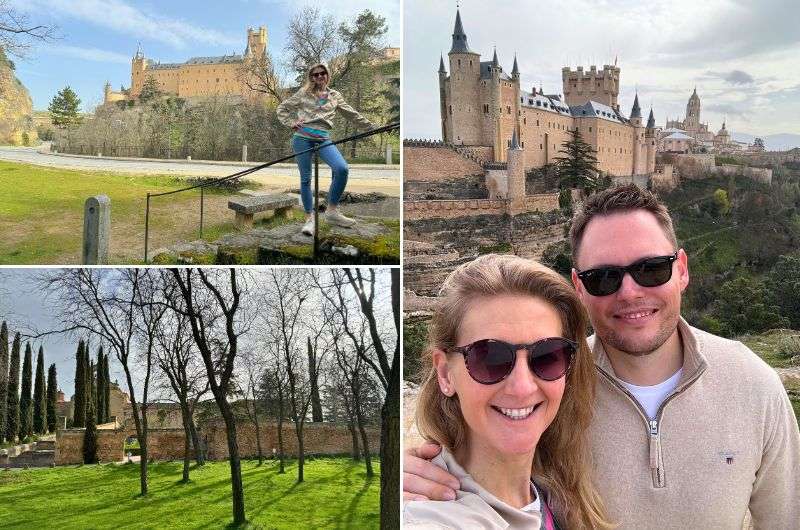
You'll leave Alcazar with lots of great photos. I guarantee it.
Tip: Be sure to turn around as you approach the castle, you’ll be getting some great cathedral photo ops!
The inside of the spectacular Alcazar of Segovia is… mundane and castle-y. Not ugly or terrible, just not anything that special apart from a cool ceiling here and an interesting old display there. But the throne room! It might be the first I’ve ever seen with my own eyes, and it’s easily one of the best. And the military museum is awesome, I’ll give them that. And the views from the ramparts…
One fact you can’t miss is that this place is enormous. This fortress has served as a royal palace, military academy, and even a state prison. And the Spaniards nailed it by turning it into a military museum instead of stuffing it with random rococo fireplaces. Trust me, every kid’s (and adult kid’s) dream is a castle full of ancient weapons, not delicate porcelain.
The exhibits are entirely in Spanish, but don’t worry, there’s an audio guide you get on your cell phone that speaks English.
The museum is packed with weaponry from the 15th and 16th centuries—late medieval and early Renaissance periods. The museum’s focus on artillery and its influence on science is something I never thought about before, but it’s fascinating.
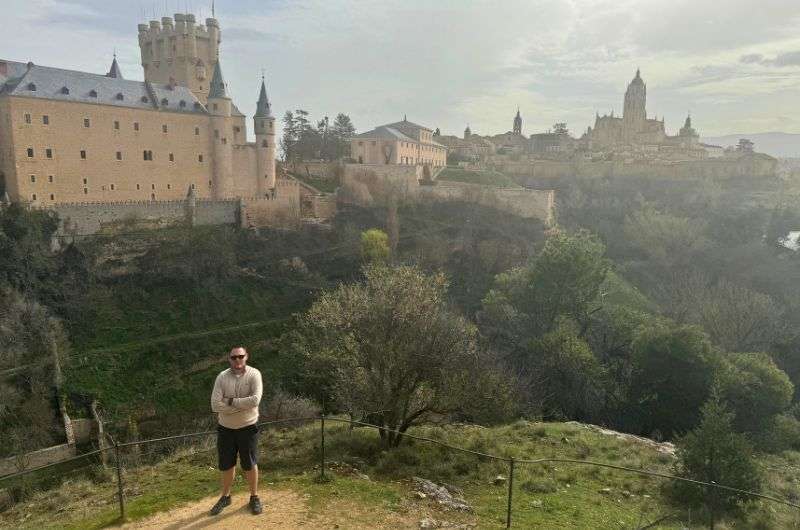
Take your time exploring Alcazar
One of the best parts of visiting the Alcázar is the walk along the ramparts. The views of the surrounding countryside and the city are amazing.
The spiral staircase up to the tower is a head-spinning 150+ stairs, but the views (yes, more views!) are worth it.
It’s the perfect way to reflect on your Segovia adventures before diving into the grand finale: pigging out on cochinillo. We made the mistake of having roasted baby pig for lunch, and let’s just say I couldn’t even think about eating anything else for the rest of the day. It’s not ideal when you have another half day of exploring ahead of you.
Stop 11: Eat cochinillo, a local delicacy

Bon apetit!
Distance from last stop: 1.2 km (0.8 mi), a 20-minute walk
Time spent here: 30 minutes
Opening hours: Daily 8 am–8 pm (for the sanctuary)
Price: Free
Tip: If you prefer to eat dinner earlier or are in a hurry to get back to Madrid, you may want to have dinner first and then head up to the viewpoints right after.
No Segovia visit would be complete without trying the local delicacy, cochinillo aka roasted suckling pig. It’s as bad as it sounds, and soooo delicious!
We ate ours at José María Restaurant, a Michelin-starred restaurant located close to Plaza Mayor. It’s a traditional place that is famous for its three-week-old suckling pigs.
This dish is a Segovian specialty and is available in other restaurants, but José María is arguably the most renowned. Plus, it’s not as expensive as you might think. For EUR 30, you get a sixth of a piglet, which is plenty to stuff your belly. Service was ok, not spectacular, but the food was to die for.
Make sure you book your table—either on their website if booking further in advance, or by email or phone if booking less than 2 days before your visit.
We had our piglet for lunch and almost rolled out of the restaurant with zero ambition to eat until the next day. So, pro tip: Have cochinillo for dinner.
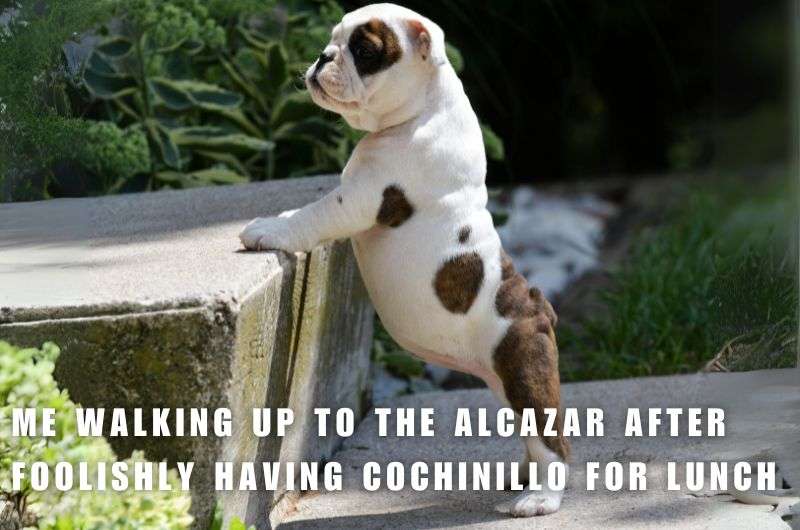
You’ve successfully seen Segovia in one day, congratulations! Did you love it? I did. I also loved Ávila, just 1 hour away. That’s another day trip from Madrid waiting for you… Oh, and don’t forget Toledo! Yeah, that’s why we needed a week to see it all.
FAQ 1: Does Segovia have a train station?
Yes, Segovia-Guiomar is the train station you’ll arrive at from Madrid, just a 20-minute walk or a short taxi ride to the city center. Convenient and no parking nightmares!
FAQ 2: How many days do you need in Segovia?
One day in Segovia is enough to hit all sights, there wouldn’t be much else to do for another day. But don’t fall for those group tours doing Segovia and Ávila in the same day. That’s like speed dating history. I’ve even seen one that does Ávila, Segovia, and Toledo in a single day! Insanity.
FAQ 3: Is one day in Segovia enough?
Absolutely, one day is perfect for Segovia. There isn’t anything we missed and we were only there for a single day from Madrid.
FAQ 4: Why go to Segovia?
Segovia’s got a 2000-year-old Roman Aqueduct, a castle that could be a Disney set, a huge and wonderful cathedral, and cochinillo—roast suckling pig that’ll blow your mind. Most of all though, the views of the town are exceptional.
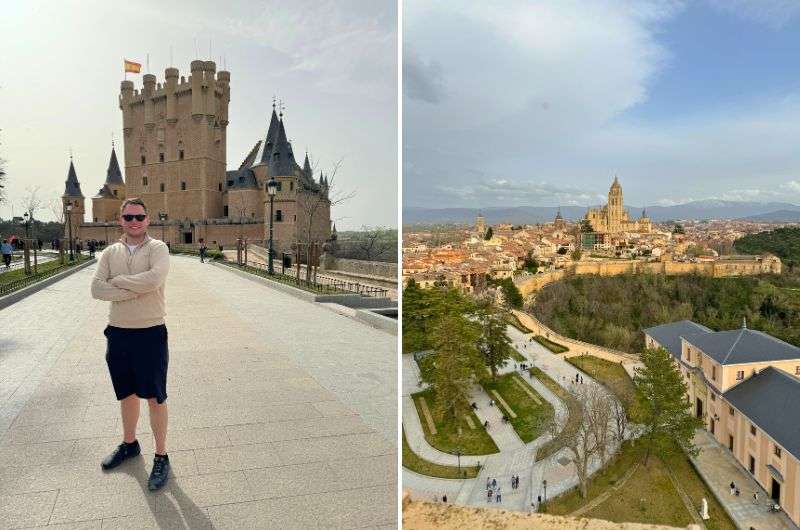
Why go to Segovia? For many reasons!
FAQ 5: Is Segovia a day trip from Madrid?
Totally, just a 30-minute high-speed train ride and you’re there. Easy peasy.
FAQ 6: What’s famous in Segovia?
The Roman Aqueduct, the Alcázar (castle), and Segovia Cathedral. And cochinillo. Did I mention the pig yet?
FAQ 7: Can you tour Segovia on your own?
Yes, Segovia is super walkable. No need for a guide. Wander around and soak in the history at your own pace. I wouldn’t have it any other way. Lucky for you, you’ve just landed on my Segovia itinerary, so you’re all set for a self-guided Segovia tour.
FAQ 8: Is Segovia or Toledo better?
Toledo offers more diverse experiences with its rich Islamic legacy and Andalusian vibe, which I found refreshing. However, Segovia holds its own with stunning views and historical charm. Each city has its unique appeal, but Toledo stands out for its museums and distinct atmosphere.
FAQ 9: Can I do Toledo and Segovia in one day?
No way, José, you’ll miss everything good if you try to see both cities in one day. Pick one and enjoy it properly. And then pick the other and enjoy it the next day.
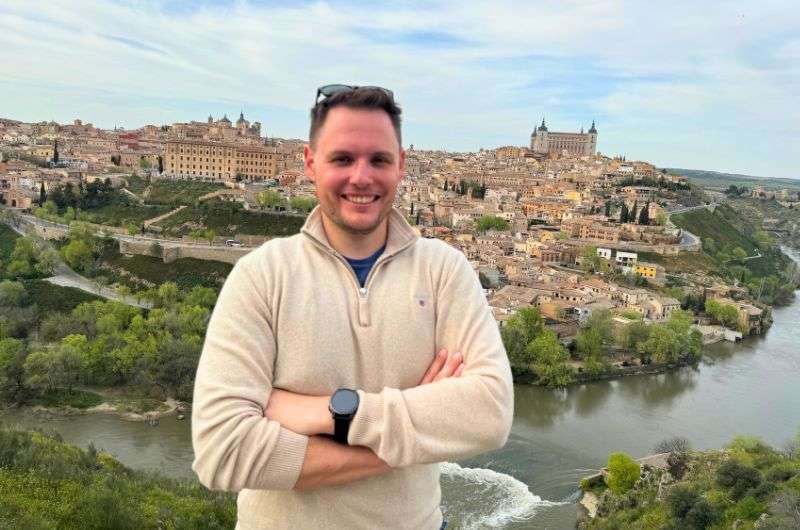
Trust me, you should give Toledo a full day like I did
FAQ 10: Is there an entry fee for the Aqueduct of Segovia?
No entry fee, the Roman Aqueduct is free to admire. Take all the selfies you want. And make sure to turn on your curiosity and go searching for the start of the aqueduct—it’s like finding the beginning of a rainbow!
FAQ 11: Can you go inside Segovia Castle?
Yes, you can go inside Segovia Castle, but I didn't like it as much as I thought I would. The sight of the castle from the viewpoints around the city trumps anything you can see inside of it, but there is a fantastic military museum inside. And I especially enjoyed walking the ramparts, which technically isn't inside the castle, but you get the point.
You might also be interested in reading:
- 10-Day Spain Itinerary
- 10 Best Places to See in Mallorca
- 5 days in Barcelona (with day trips)
- How to Visit the Alhambra in Granada
- Andalusia Itinerary: Southern Spain in 10 Days
This post contains affiliate links. I earn a small commission if you make bookings through my links, at no additional cost to you. Thank you for your support!


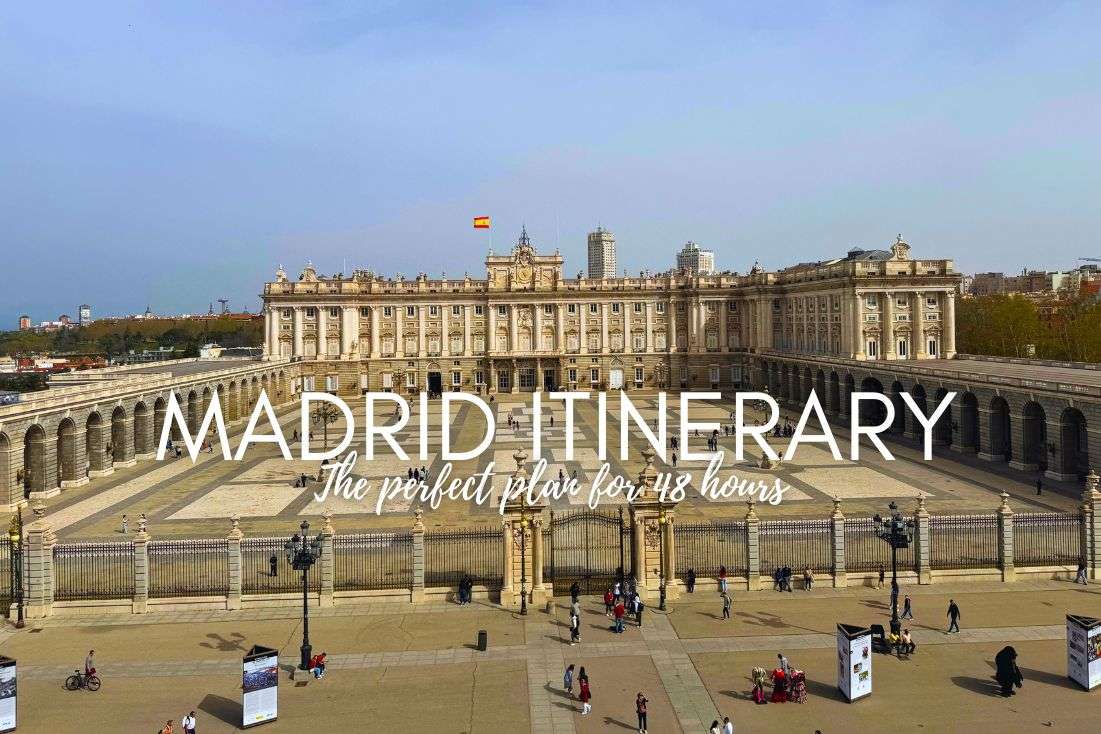
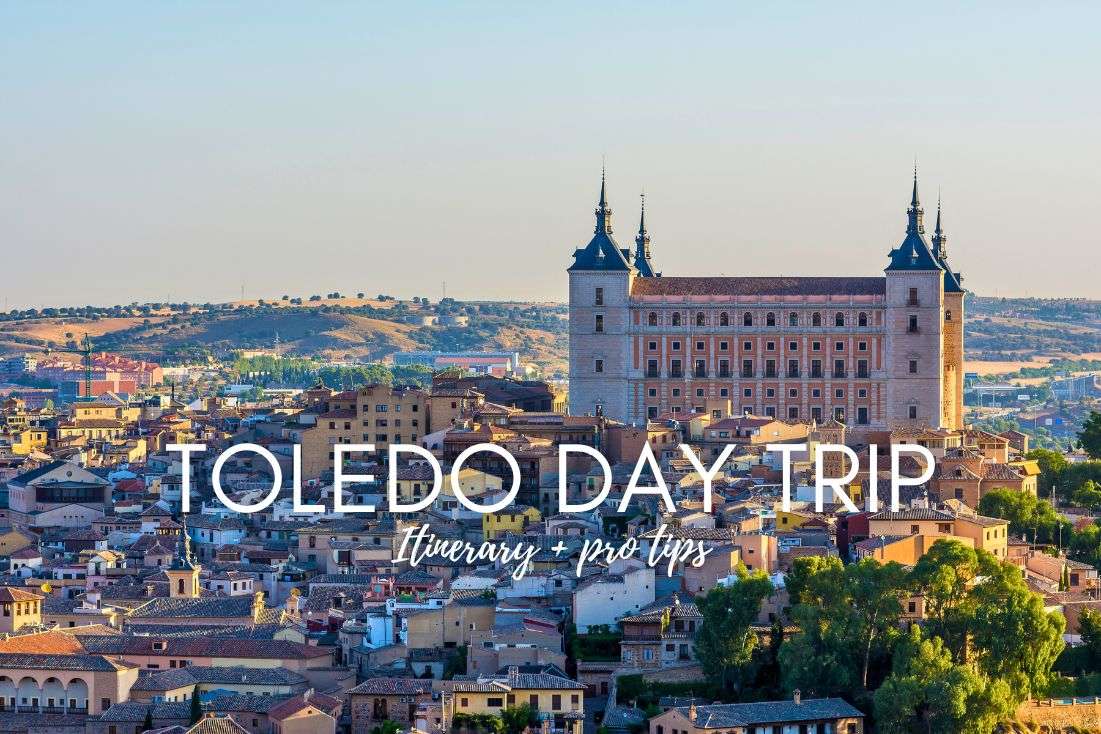
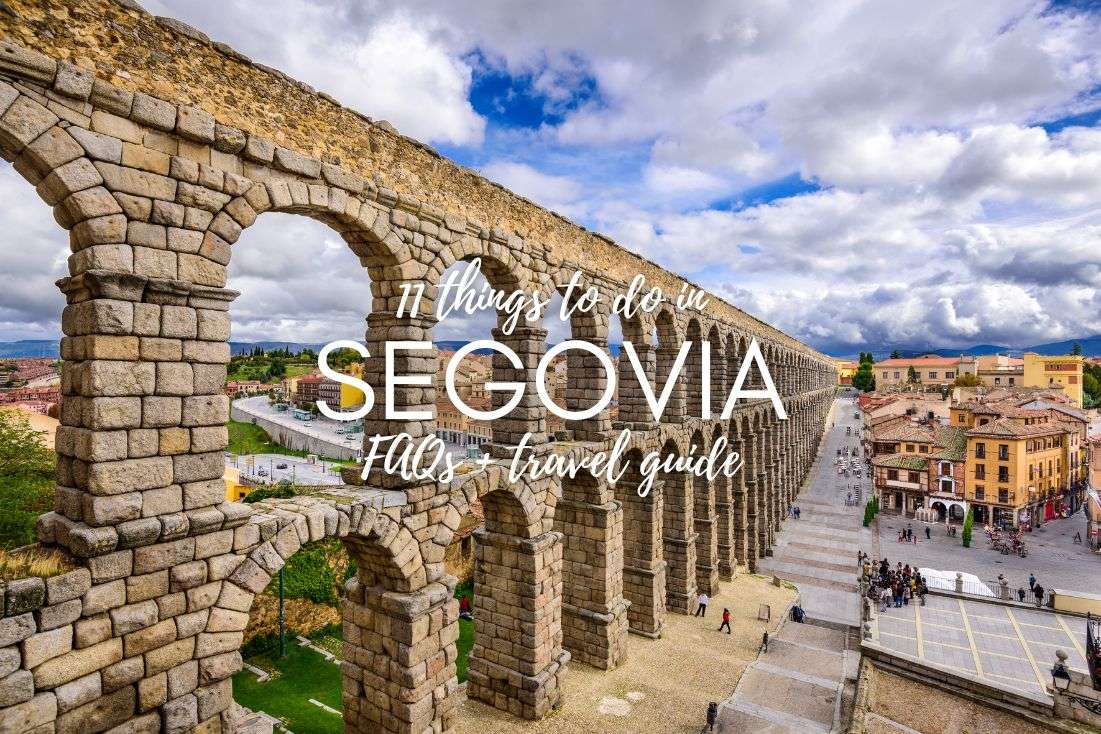





Comments | Thoughts? Give us a shout!